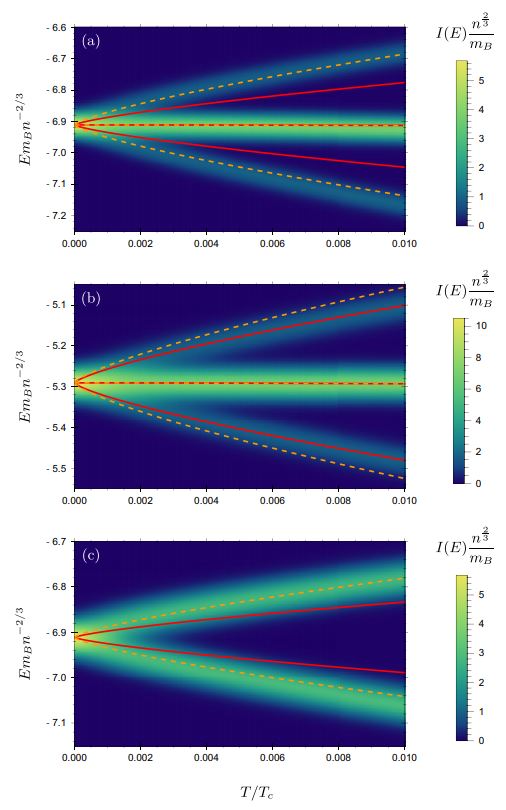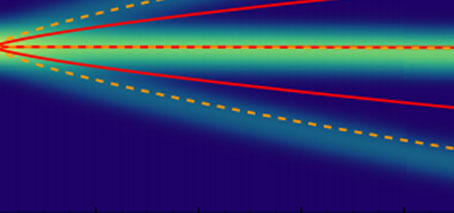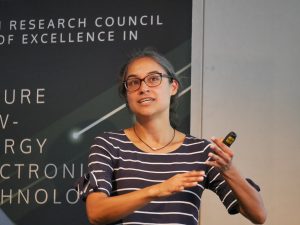A new theoretical study at Monash University has improved our understanding of the interplay between quantum and thermal fluctuations (or excitations) in quantum matter.
The study found that an impurity within a Bose-Einstein condensate (BEC) exhibits an intriguing energy spectrum as its temperature is raised above zero kelvin, with the ground-state quasiparticle splitting into a number of branches that depends on the interactions with the thermal cloud surrounding the BEC.
“The modelling demonstrated that the number of quasiparticle branches is simply set by the number of hole excitations of the thermal cloud,” explains lead author, Bernard Field.
“That is, including up to one hole yields one split, two holes yields two splits, and so on,” says Bernard, who is a PhD student within the School of Physics and Astronomy at Monash University.
Cold atomic gases as a ‘perfect testbed’
Bose-Einstein condensate: a quantum state occurring at ultra-cold temperatures, in which quantum effects can be observed at a macroscopic scale
Cold atomic gases are used to study the effects of impurities coupled to a quantum medium – a scenario that is relevant to everything from field-effect transistors to the behaviour of protons in neutron stars.
Cold atomic gases provide a particularly clean and flexible system in which to probe the behaviour of quantum impurities, allowing impurity-medium interactions to be varied from weak to strong coupling and revealing the manner in which the impurity becomes ‘dressed’ by excitations of the medium.
Specifically, the new study focusses on impurities in a BEC, referred to as a Bose polaron.
Previous studies had predicted that the energy spectrum of a Bose polaron would split into two even branches with any temperature increase above zero kelvin.
The Monash study found that this result is a consequence of assuming only a single particle-hole excitation of the medium. When more holes are included, the result is more splitting.
“Since there can be a large numbers of excitations in a real system, we expect that the actual Bose polaron will appear as a single broad peak at low temperatures,” explains A/Prof Meera Parish.
“However, remarkably we find that the behaviour is fundamentally different from what one might expect from standard theories of quantum fluctuations and quantum phase transitions.”
The researchers make use of an elegant variational approach that includes multibody correlations between the impurity and the BEC, thus going beyond the current state of the art in the field. Most notably, their theoretical result for the ground-state energy of the Bose polaron is in excellent agreement with more numerically intensive quantum modelling and with experiments.
The study

Spectra vs temperature for (a) the full threebody ansatz, (b) three-body ansatz without two-particle terms,
(c) three-body ansatz without two-hole terms.
Fate of the Bose polaron at finite temperature was published in the journal Physical Review A in January 2020 (DOI 10.1103/physreva.101.013623).
As well as support from the Australian Research Council (Centres of Excellence and Future Fellowship programs), support was received from the Australian Government’s Research Training Program.
Studying fundamental, dynamic quantum systems at FLEET
Bernard Field conducted the study in A/Prof Meera Parish’s group at Monash University, which investigates the behaviour of large groups of interacting quantum particles, which can exhibit exotic behaviour, such as superfluidity where they flow without encountering resistance.
Fundamental knowledge of quantum systems such as cold atomic gases, superfluids and BECs is sought at FLEET toward developing a new generation of near-zero resistance, ultra-low energy electronic devices.
The study of such non-linear, quantum systems falls into FLEET’s Research Theme 3, specifically the impact of impurities dynamically coupled to Fermi or Bose superfluids.
More information
- Contact A/Prof Meera Parish Meera.Parish@monash.edu
- Watch Future solutions to computation energy use
- Connect @FLEETCentre



